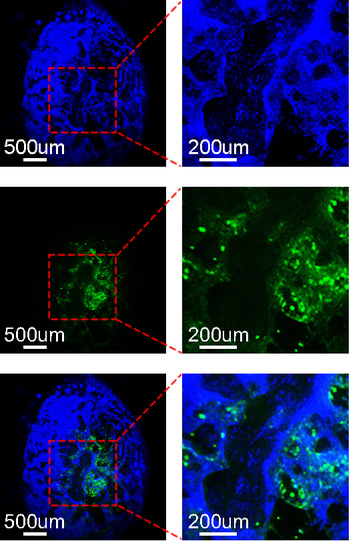2019年8月,我校庄松林院士团队超精密光学制造课题组张大伟教授、戴博副教授、郑璐璐老师、万新军老师、焦子傲同学的最新成果论文《Colour compound lenses for a portable fluorescence microscope》在国际光学顶尖期刊《Light: Science & Applications》(影响因子14.098)上发表。戴博、焦子傲和郑璐璐为第一作者,张大伟和Tony Jun Huang为通讯作者。
该成果与美国杜克大学、美国戴顿大学、复旦大学、复旦大学附属肿瘤医院合作,主要研制了一种彩色液滴透镜器件,并实现了基于智能手机的便携式荧光显微成像应用。
荧光显微成像技术是实现生物样品观测与生化指标检测的重要方式之一,传统的荧光显微检测只能在实验室利用昂贵的荧光显微镜实现,为了解决设备昂贵、携带不便等问题,研究人员受到“葡萄酒滤光现象”的启发,利用蒽醌染料对高分子聚合物和高折射率硅油进行染色,通过光流控技术,创新制作了多款彩色复合液滴透镜,该透镜可同时实现图像放大及光学滤波的功能。并且,通过将透镜安装于手机上,实现了细胞观察、细胞计数、肿瘤组织切片荧光检测、质粒转染表达检测、细胞凋亡超氧化物生成检测等应用,得到了同行专家的高度认可。该研究成果可广泛用于生物医学即时检测的应用环境,为医疗资源匮乏地区以及战场医学提供有效技术保障。
该研究项目得到了国家重点研发计划、国家自然科学基金、上海市科学技术委员会项目的资助。

图1彩色液滴透镜及便携式荧光显微镜

图2小鼠黑色素瘤细胞细胞及肿瘤组织切片观察
论文链接:https://www.nature.com/articles/s41377-019-0187-1
B. Dai, Z. Jiao, L. Zheng, H. Bachman, Y. Fu, X. Wan, Y. Zhang, Y. Huang, X. Han, C. Zhao, T. J. Huang*, S. Zhuang, D. Zhang*, “Colour compound lenses for a portable fluorescence microscope,” Light: Science & Applications, vol. 8, article no. 75, Aug. 2019.
Editorial Summary
Fluorescence microscopy: Smartphone solutions for seeing cells
A method of turning a smartphone into a fluorescence microscope, developed by researchers in the US and China, enables complex biomedical analyses to be performed rapidly and inexpensively. Conventional fluorescence microscopes are vital for detecting specific cell types and proteins, but are bulky and inconvenient for point-of-care diagnoses. Tony Jun Huang at Duke University, Dawei Zhang at USST and co-workers used liquid polymers to create miniature lenses comprising two droplets, one inside the other, dyed with colored solvents. The lenses, which are compatible with several different smartphone cameras, allowed the researchers not only to observe and count cells, but also to monitor the expression of fluorescently-tagged genes, and to distinguish between normal tissue and tumors. This ingenious use of easily-accessible and affordable smartphone technology will lead to better on-site personalized medicine, especially for developing countries.
供稿:光电学院










